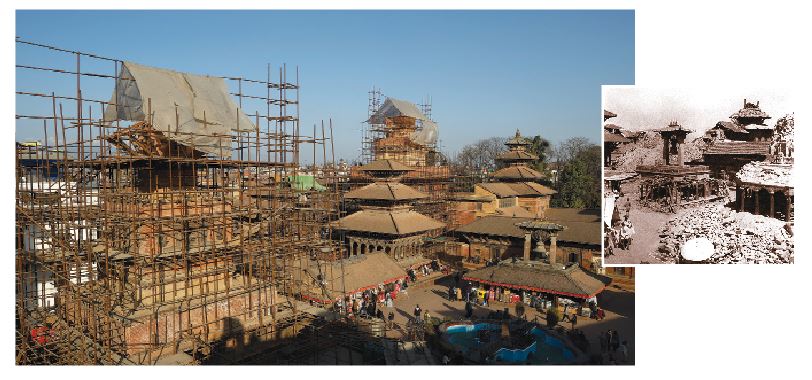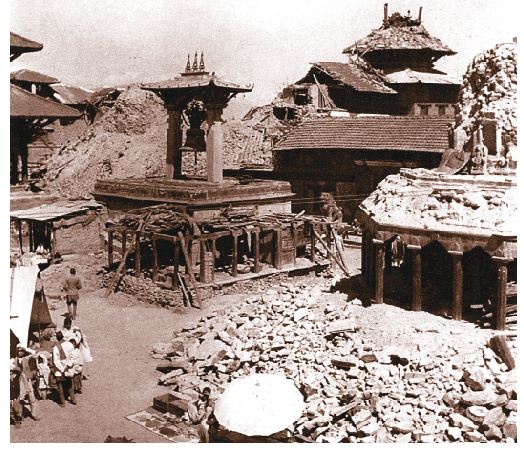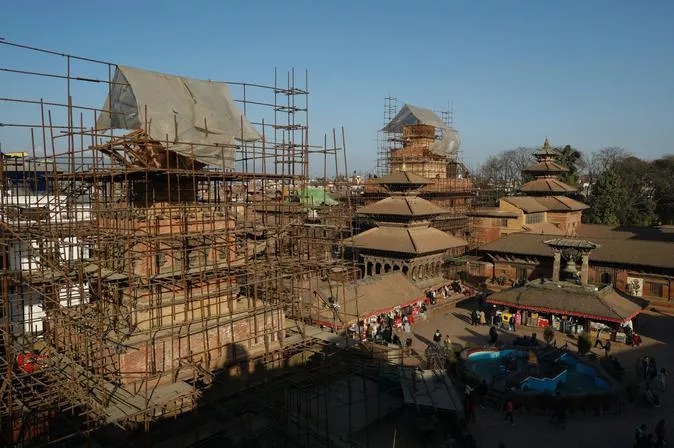by Nepali Times
The Great Earthquake of 1934 is known by the Nepali year it happened: Nabbe Sal
Exactly 90 years ago this week, Nepal was struck by the Great Earthquake of 1934 killing over 8,500 people across the country. In Kathmandu, 70% of the houses collapsed in the 8.3 magnitude disaster.
To commemorate the event, 16 January is observed every year as National Earthquake Safety Day.
Nepal has gone through many transitions in the past 90 years. From the Rana era to the 1950s interim years, to the Panchayat, the conflict and federal republic.
Nepal has also experienced many other smaller seismic events, including the 2015 Gorkha Earthquake which ended up killing nearly 9,000 people and damaging some 800,000 buildings. And as the 3 November 2023 earthquake in Jajarkot showed, Nepal is still not prepared for these disasters.
Read also: Jajarkot survivors show collective resilience, Durga Rana magar
‘There was a movement in the land similar to that of the waves in the water … the land seemed to twist and most of the buildings toppled. The movement was so strong … the trees bent down as during a hurricane,’ narrates Brahma Shumsher Rana in his book Nepal ko Mahabhukampa which came out later that year.
Bramha Shumsher was the son of Major General Baber Shumsher and describes how the ground split sending fountains of hot water and sand shoot up. The Bagmati and the Vishnumati rivers turned black with dirty water.
‘Some sought support to keep themselves on their feet, while others ran like animals with their hands on the ground. Some mothers having come out into the open ground went back for the love of their children and were crushed to death… But even those men who ran away were not saved. The narrow streets and lanes in the towns became traps,’ the book says.
Read also: In a disastrous state, Sonia Awale
Nepal is a seismically active zone and is struck by such earthquakes every 70-80 years. The 7.8M Gorkha quake in central Nepal in 2015 is often mistaken for one of those megaquakes. Himalayan seismologist Roger Bilham told Nepali Times then that it was not the big one which scientists had feared.

In fact the faults in Central Nepal are still collecting energy and could be let off at any time. But even more imminent is the long seismic gap in western Nepal which did not dissipate all its energy in the November quake, says engineer Surya Narayan Shrestha of the National Society for Earthquake Technology (NSET) – Nepal.
The last big quake in western Nepal in 1505 is estimated to be 8.9M and killed one-third of Kathmandu Valley’s population including the king, devastated north India, and created the debris flow where Pokhara city is situated today.
Read also: Back to classroom for earthquake preparedness, Rachael Lau
“Energy accumulated in western Nepal is big enough to cause an earthquake bigger than 8M, the Jajarkot earthquake released very minimal stress,” Shrestha explains. “This means there is still the possibility of a 1934 type event in Kathmandu, which could be deadlier because of the larger population.”
The Himalayan Thrust fault system means a mega quake can happen anywhere in western Nepal from the Mahakali or Palpa. Either way, an 8M earthquake in western Nepal would immediately destroy 1.5 million buildings across the country and kill 100,000 people, if it struck at night.
Hospitals would have collapsed too. Few still standing would be overwhelmed with some 200,000 individuals estimated to be seriously injured. Substandard schools and public buildings would go down like a house of cards. Electricity, highways, telecommunication and drinking water systems would be disrupted.
The 2015 earthquake should have been a lesson to Nepalis to be prepared for a mega-quake, especially in terms of building safer structures. To be sure, 90% of the rebuilt structures do follow the government building code, but many in Kathmandu have blatantly flouted rules.
Read also: Be prepared, Editorial
“We have policies and legal frameworks in place but our preparedness is still negligible,” warns Shrestha. “The existing structures are already vulnerable but newer buildings even more so.”

Following the 1934 earthquake, a geologist and engineer identified only as Mr Eden made some observations and gave a series of instructions regarding safe building in Nepal, which was published in Gorkhapatra at the time.
He notes: ‘Bhaktapur, Harisiddhi, Khokana and Bungamati areas are liable to greatest destruction in an earthquake while Pashupatinath, Baudha and Gokarna are to be least feared. Syambhu and Kirtipur are similarly free from danger. In the Nepalese Terai, it is not advisable to build houses close to streams, rivers and tanks.’
Read also: Lessons still not learnt, Sonia Awale
Eden also pushed for earthquake-proof buildings with details about what kind of buildings to construct and where. ‘The type of the soil is not the only factor that causes destruction in an earthquake. It also depends upon the structural design, the materials used and the skills of the builders,’ he is quoted as writing.
Nearly a century ago, we already knew what to do.
Concrete buildings are not necessarily stronger. In fact, substandard concrete buildings are even more of a death trap, especially given that Nepal does not have the search and rescue teams and equipment for such collapsed structures.
Warns Shrestha: “A 8M earthquake will happen one day, and all these substandard buildings will come crashing down. It will be a calamity of epic proportions.”
Read also: Past disasters foretold, Om Astha Rai
Sonia Awale,WRITER
INPS Japan/Nepali Times


